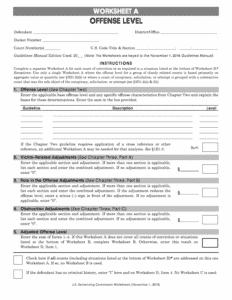Sentencing Worksheet | How Federal Courts Determine Sentences
Did you ever wonder how a judge arrives at the criminal sentence he or she imposes in federal court? Is it gut instinct? Are there law books to consult? In fact, federal judges typically go through a rigorous analysis of the case before arriving at a sentence consistent with the United States Sentencing Guidelines and other statutory factors. To help determine what the sentence should be under the advisory Sentencing Guidelines, courts rely upon aPre-sentence Investigation Report which is prepared by a U.S. Probation Officer using the Sentencing Worksheet.
This article will take you through the ins and outs of the Sentencing Worksheet so you can have a better understanding of all the factors that go into the ultimate sentence a judge hands down.
Sentencing Worksheet A – OFFENSE LEVEL
The United States Sentencing Guidelines focus on two major factors: the seriousness of a crime, and the convicted person’s criminal history. In Sentencing Guideline terms, the seriousness of a crime is called the “offense level.” Accordingly, judges must first determine the seriousness of the offense – or offense level.
Worksheet A of the Sentencing Worksheet helps the judge in that regard. Here is a breakdown of how the worksheet operates.
- Offense Level: For this first number, the court will consult the Sentencing Guidelines to determine the “base offense level” for a crime. For example, if a person was convicted of Assault, the base offense level is 7 if the offense involved physical contact, or if the defendant threatened use of a dangerous weapon. Otherwise, the base offense level is 4. In addition, if the victim sustained bodily injury, the base offense level goes up 2 levels. If the victim was a domestic partner, or minor, then the offense level goes up 4 levels.
- Victim-Related Adjustments: The court then looks to the Sentencing Guidelines to consider any “victim-related adjustments.” In other words, if the victim had special characteristics that warrant an offense level adjustment. For example, if the victim was a police officer, the Sentencing Guidelines call for an increase of 3 levels.
- Role in the Offense: The offense level takes into consideration the defendant’s role in the offense. For example, if the defendant was an organizer of the criminal activity (an aggravating role), then the offense level should go up at least 2 levels. By contrast, if the defendant was a minor participant in the offense, the offense level should go down by at least 2 levels.
- Obstruction: The court must also consider, as part of the offense level, whether the defendant willfully obstructed or impeded the investigation or prosecution of the offense. If so, that is a 2 level increase in the offense level.
After looking at the four categories above, the court arrives at an “Adjusted Offense Level.” As a quick example to see how this works, let’s take the Assault offense mentioned earlier. Using the Sentencing Worksheet, the base offense level is 7 because the defendant threatened the victim with a knife. Assume in our example that the victim of this particular Assault was a police officer. The court would then add 3 levels to the offense level, bringing the number to 10.
The court would then look to the defendant’s role in the Assault. Assuming that the defendant was the sole assailant, then no real aggravating or mitigating role adjustment need apply. Let’s assume defendant obstructed justice. Because of the obstruction, two more levels would be added.
Thus, an overall Adjusted Offense Level of 12 is produced.
Sentencing Worksheet B – MULTIPLE COUNTS
Without going into too much detail about this part of the Sentencing Worksheet, Worksheet B helps the court to determine the offense level when a defendant is convicted of multiple counts. In many cases, certain closely related counts can be “grouped” into one for purposes of arriving at the correct offense level number.
Sentencing Worksheet C – CRIMINAL HISTORY
The next worksheet touches upon the second fundamental consideration under the Sentencing Guidelines – the defendant’s criminal history.
Generally speaking, the judge must take a defendant’s criminal history into account. The Sentencing Worksheet allows 3 points for each prior sentence of imprisonment exceeding one year and one month, 2 points for each prior sentence of imprisonment of at least 60 days, and 1 point for each prior sentence.
In our example, let’s assume that the defendant served a 45-day jail sentence 5 years ago for a prior criminal offense, and that is the extent of his criminal history. In that case, the judge will factor in 2 criminal history points. The Sentencing Worksheet notes that 2 to 3 criminal history points means that the defendant is in Criminal History Category II.
Sentencing Worksheet D – DETERMINING THE SENTENCE
In this final worksheet of the overall Sentencing Worksheet, the court puts all the factors together. The process on the Sentencing Worksheet flows in the following way:
- Adjusted Offense Level: The Adjusted Offense Level is transferred to Worksheet D. In our hypothetical, the Adjusted Offense Level was 12, and there was no issue regarding multiple counts.
- Acceptance of Responsibility: If the defendant “clearly demonstrates” acceptance of responsibility for his crime then the judge may decrease the offense level by 2. The judge may also decrease by 1 more level if the initial Adjusted Offense Level is 16 and the defendant willingly avoids a trial by pleading guilty. Let’s say that the defendant in our example did not show remorse for the assault, and therefore does not deserve a decrease for this category.
- Offense Level Total: Given that our hypothetical defendant did not clearly accept responsibility, the Offense Level total is 12.
- Criminal History Category: Here, the calculation transfers from Worksheet C, the criminal history category. In our hypothetical, the defendant was in Category II.
- Terrorism; Career Offender; Criminal Livelihood; Armed Career Criminal; Repeat and Dangerous Sex Offender: In this category, the court consults the law to determine whether the defendant falls under any of the listed categories. Let’s assume in our case that the defendant does not apply to that list.
- Guideline Range from Sentencing Table: At this point, the court consults the Sentencing Table to determine the defendant’s sentencing range. For a Offense Level of 12 and Criminal History Category of II, the range according to the table is 12 to 18 months in prison.
In sum, it appears that our hypothetical defendant (someone who assaulted a police officer while threatening a with knife, and resisted arrest) is facing a sentence of one to one and a half years in prison for the crime.
The Sentencing Worksheet continues, allowing the court to (i) fill out certain sentencing options based on where the numbers land in the Sentencing Table, (ii) determine the term of probation, (iii) determine the term of supervised release, (iv) decide on restitution or fines, if any, and (v) explain any factors that allow for a “departure” from the range identified in the Sentencing Table, or a “variance” from the Sentencing Guidelines.
Overall, the Sentencing Worksheet is a useful tool to ensure that federal courts consider all factors and important statutory rules. Thus, the Sentencing Worksheet instills some rigor in the sentencing process, and reminds U.S. Probation officers and courts of all of the important elements that go into a criminal sentence.
If you need assistance with your sentencing hearing, or want to challenge your sentence after the fact, be sure to consult Brandon Sample, Esq. Brandon is a nationally known federal criminal defense attorney. Call 802-444-HELP for a free consultation and to learn more about what Brandon can do for you.
Recommended for you
Amendment 782 Motion Reconsideration
Reinaldo Rivera moved for 18 U.S.C. § 3582(c)(2) relief based on Amendment 782 to the Guidelines, commonly known as “drugs minus 2.” The district court granted the motion and reduced his sentence to 420 months from LIFE. But in doing so, the district court believed Rivera’s mandatory minimum was 30 years for his CCE conviction.…
Drug Treatment And Vocational Training Improper Sentencing Considerations
Christopher Thornton moved for a downward variance at sentencing arguing, among other things, that “in-prison treatment during the proposed thirty-eight months would help mitigate any potential risk he posed to the community.” The district court denied the motion, but in doing so said that Thornton had “mental-health issues, and he needs drug treatment” and that…





